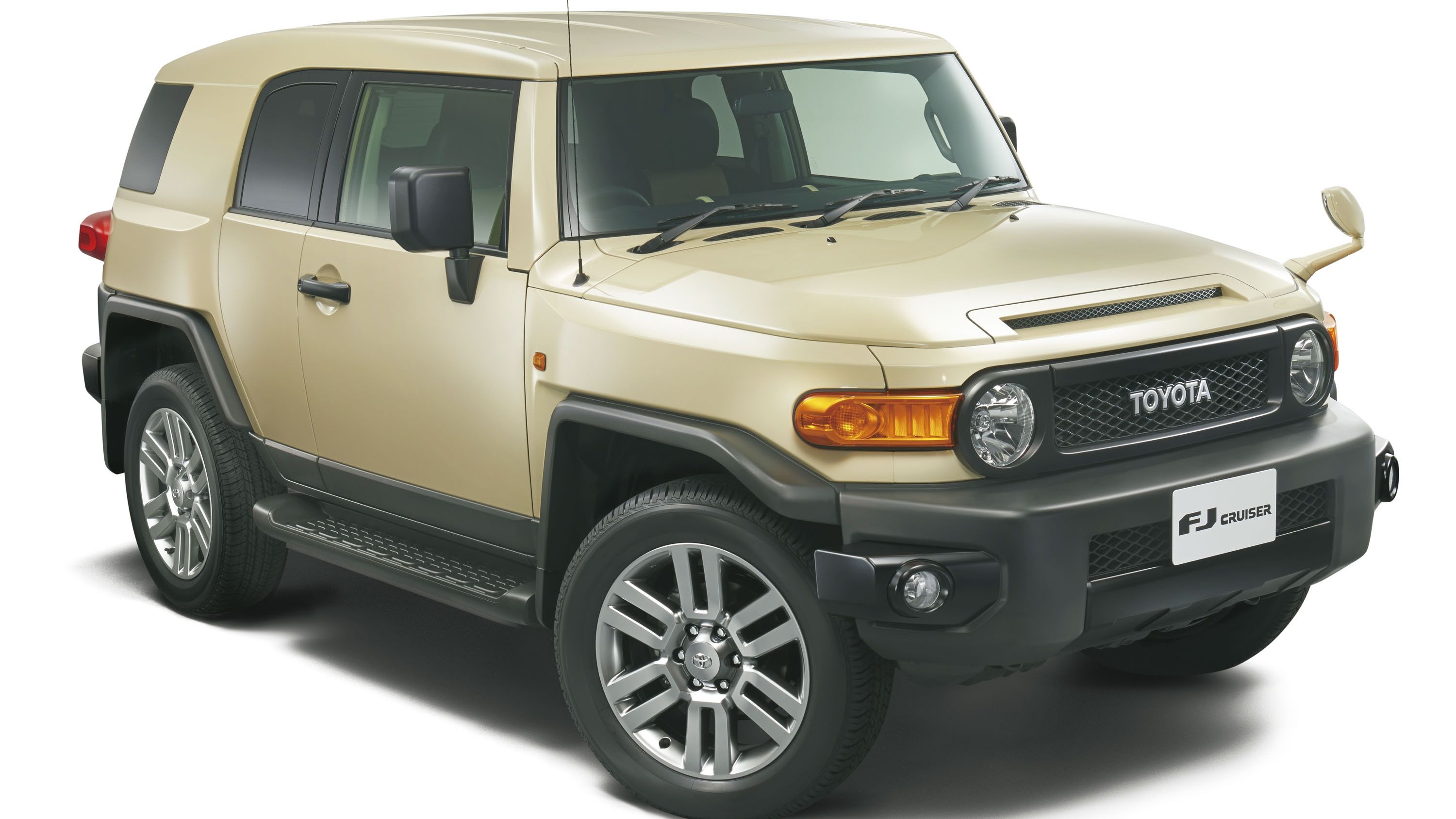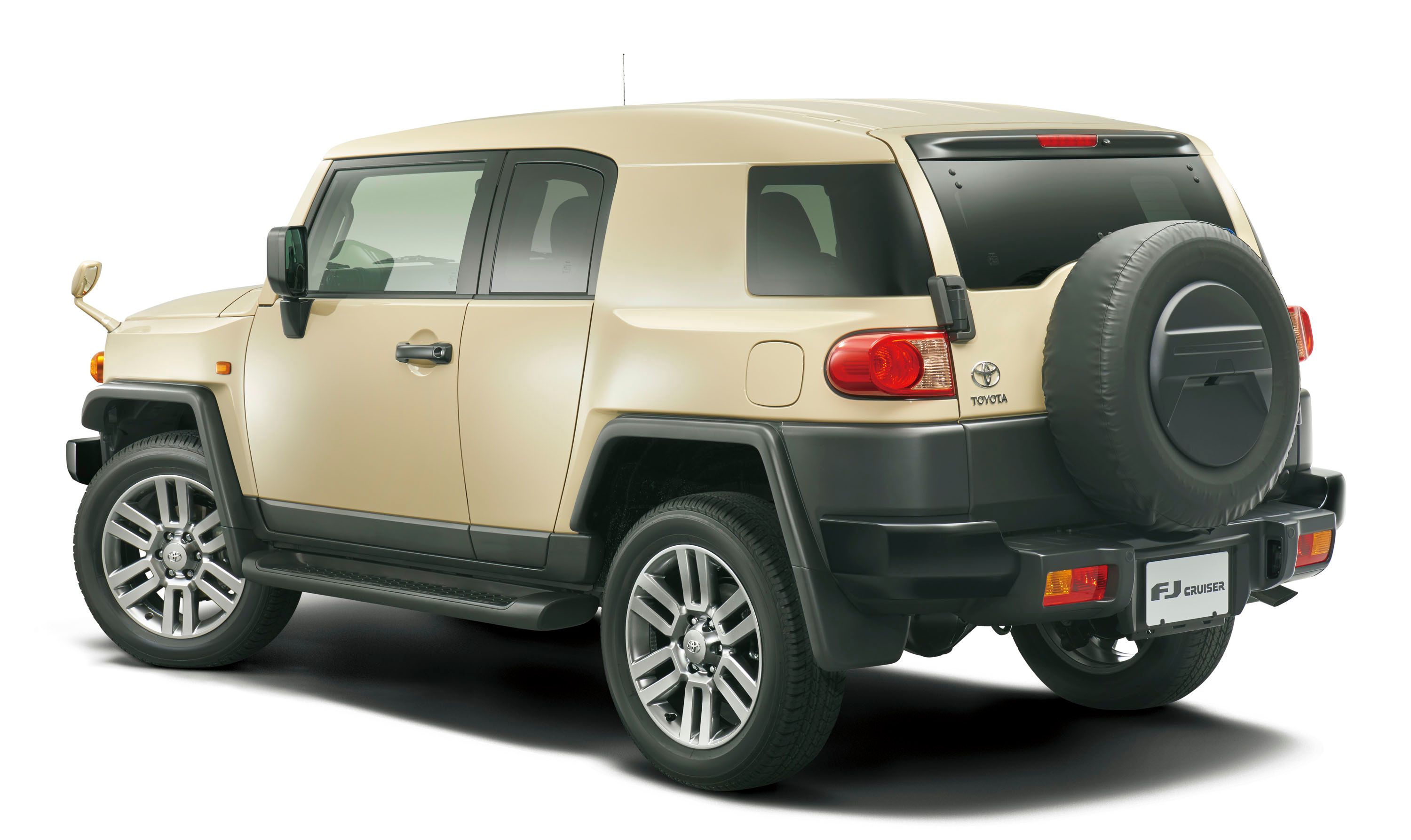Toyota is ending production of the FJ Cruiser more than a decade after the retro-styled SUV hit U.S. shores. But, if you’re like most, you thought the FJ Cruiser was dead since 2014 when it stopped sitting in Toyota showrooms here in the U.S. However, that’s not the case as the 4Runner-based SUV has been on-sale in Toyota’s home market of Japan. Toyota isn’t giving the FJ Cruiser a loveless ending, though. The automaker is releasing a special edition of the FJ Cruiser appropriately dubbed the “Final Edition.”
The FJ Cruiser Final Edition is a Japan-only model and comes in a single color option: Beige. The spartan interior also gets the beige treatment with beige center sections on the cloth seats and beige trim on the dashboard. Other changes include 20-inch alloy wheels, black side steps, and that cool JDM mirror on the front fender. Toyota isn’t changing anything with the drivetrain – and why would it? The FJ Cruiser has soldiered on for a decade with that tired 4.0-liter V-6 and five-speed automatic transmission. 4WD is most likely standard, but at the very least, is an option. Of course, the FJ Crusier’s most endearing quality is its ruggedness afforded by its body-on-frame construction, solid rear axle, independent front suspension, and its part-time 4WD system. An honest SUV was hidden under that retro bodywork and awkward interior. It was the FJ’s weirdness that both gained it a loyal following and ultimately brought its demise. Sales exceeding 55,000 in 2006 and 2007 quickly nosedived during the recession of 2008 and never recovered. Toyota only managed to sell 14,718 in 2014, making the bean counters’ decision to axe the SUV within the U.S. an easy one. Compare that to the 4Runner’s U.S. sales in 2014 of nearly 77,000 and its sales in 2016 of 112,000. It’s clear which body-on-frame SUV Toyota customers wanted.
Continue reading for more on the Toyota FJ Cruiser.
A Brief History of the FJ Cruiser
The FJ Cruiser first saw life as a concept vehicle in 2003 at the Detroit Auto Show. Toyota moved the FJ into production in 2006 as a 2007 model, keeping its design surprisingly close to the concept. The FJ Cruiser rode on a ladder frame shared with the Toyota 4Runner, which was based on the Toyota Land Cruiser Prado. That made the U.S.-spec 4Runner and FJ Cruiser nearly identical under their bodies.
The FJ Cruiser used an independent front suspension with MacPherson struts and a solid rear axle located my a multi-link system and coil springs. Rear-wheel drive came standard, but a part-time 4WD system and a two-speed AWD system were offered. Power came from Toyota’s 4.0-liter V-6. In 2007, the engine made 239 horsepower and 278 pound-feet of torque on 91-octrane fuel, though regular unleaded would work, too. Toyota actually offered a six-speed manual transmission for those who like to row their own. A five-speed automatic was the extra-cost option.
As for those 4WD systems, the two-speed AWD system was paired only with the six-speed manual. A Torsen limited-slip center differential was used to split power between the front and rear wheels. The full-time AWD system did offer both high- and low-range gears, meaning FJ Cruisers with the manual transmission were at no disadvantage when it came to trudging through tough terrain. The five-speed automatic transmission was pairable only with the part-time 4WD system. In normal operation, power was send only to the rear wheels. When more traction was needed, the driver could shift into 4WD high range using the shift-on-the-fly transfer case’s manual shift lever. Low range was selected by coming to a stop, selecting neutral on the transmission, and moving the T-case’s shift lever into 4WD low.
Both the AWD and 4WD systems could be paired with an electronic locking rear differential, which was activate by a dash-mounted switch. All 4WD/AWD FJ Cruisers came with Toyota’s A-TRAC system, which used the brakes to individually stop a wheel from spinning should it lose traction.
In 2010, the 4.0-liter V-6 gained Dual VVT-I variable valve timing over the Single VVT-I system. This pushed horsepower to 259, though torque dropped eight poud-fee to 270. A slight bump came in 2011 with power up to 260 horsepower and 271 pound-feet of torque.
Despite the slight improvements in power, the V-6 was a dog at the pump. It only earned an EPA-estimated 17 mpg city, 20 mpg highway, and 18 mpg combined with the automatic transmission and 4WD system. The six-speed manual was even worse, getting only 15 mpg city, 18 mpg highway, and 16 mpg combined. Foregoing 4WD/AWD with the automatic transmission only pushed fuel economy to 16 mpg 20 mpg highway, and 18 mpg combined – only one mpg better in the city. Crash performance wasn’t terrible, though. The FJ Cruiser earned “Good” ratings from the IIHS in its Moderate Front Overlap and Side-Impact crash tests, along with a “Good” for head restraints and seats after 2008. It did rate an “Acceptable” in roof strength tests, however. Still, those weren’t bad scores back then.
Sadly, the 2007 – 2014 Toyota FJ Cruiser just couldn’t hang with the 4Runner. Toyota pulled it from U.S. showrooms due to slow sales and its aging design rather than spending millions on giving it a second generation. Nevertheless, the FJ Cruiser will go down as one of Toyota’s most adventurous vehicles – both in terms of its off-road abilities and as an unusual design study. Cult followings have been around since the FJ’s debut and aren’t’ likely to die off anytime soon – especially as SUVs become more and more collectable.
Note: Toyota FJ Cruiser “Final Edition” pictured here.
What do you think of the Toyota FJ Cruiser? Did you know Toyota was still building them for Japan? What about a second generation – should Toyota build one? Let us know in the comments below.
References
Toyota FJ Cruiser
Read our full review on the Toyota FJ Cruiser.


